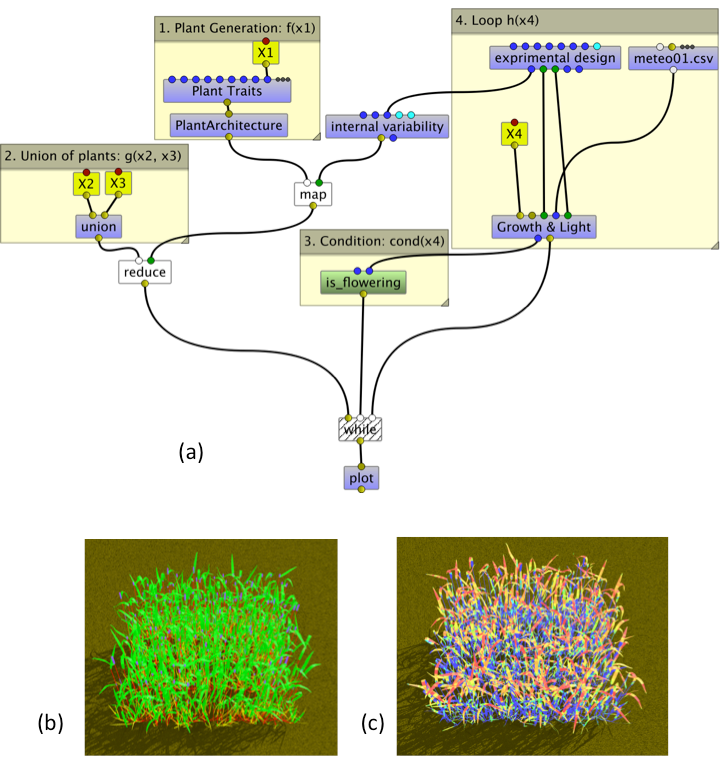Section: New Results
Generic methodological results
In the context of our research work on biological questions, we develop concepts and tools in mathematics, statistics and computer science. This paragraph is intended to put emphasis on the most important results obtained by the team during the current year in these disciplins, independently of their biological application.
Scientific workflows
Participants : Christophe Pradal, Sarah Cohen-Boulakia, Christian Fournier, Didier Parigot [Inria, Zenith] , Patrick Valduriez [Inria, Zenith] .
OpenAlea scientific workflows
Analyzing biological data may involve very complex and interlinked steps where several tools are combined together. Scientific workflow systems have reached a level of maturity that makes them able to support the design and execution of such in-silico experiments, and thus making them increasingly popular in the bioinformatics community (e.g. to annotate genomes, assemble NGS data, ...) . However, in some emerging application domains such as system biology, developmental biology or ecology, the need for data analysis is combined with the need to model complex multi-scale biological systems, possibly involving multiple simulation steps. This requires the scientific workflow to deal with retro-action to understand and predict the relationships between structure and function of these complex systems. In collaboration with the Zenith EPI, we have proposed a conceptualisation of OpenAlea workflows [34] by introducing the concept of higher-order dataflows as a means to uniformly combine classical data analysis with modeling and simulation. Ongoing work include deploying OpenAlea workflows on a Grid technology using the SciFloware middleware in close collaboration with Zenith within IBC and INRA Phenome projects.
|
Querying Scientific workflows repositories
Several workflow systems have developped scientific workflow repositories (e.g., repositories of Galaxy workflows at IBC, or repositories of OpenAlea workflows). Such repositories have grown to sizes that call for advanced methods to support workflow discovery, in particular for similarity search. Effective similarity search requires both high quality algorithms for the comparison of scientific workflows and efficient strategies for indexing, searching, and ranking of search results. Yet, the graph structure of scientific workflows poses severe challenges at each of these steps. We present a complete system for effective and efficient similarity search in scientific workflow repositories, based on the Layer Decompositon approach to scientific workflow comparison. Layer Decompositon specifically accounts for the directed dataflow underlying scientific workflows and, compared to other state-of-the-art methods, delivers best results for similarity search at comparably low runtimes. Stacking Layer Decomposition with even faster, structure-agnostic approaches allows us to use proven, off-the-shelf tools for workflow indexing to further reduce runtimes and scale similarity search to sizes of current repositories [25] . Very efficient and powerful ranking methods have been used in this work. We based our choice on the large scale study of algorithms for rank aggregation with ties we performed [56] .
Statistical modeling
Participants : Yann Guédon, Jean Peyhardi.
We develop statistical models and methods for identifying and characterizing developmental patterns in plant phenotyping data. Phenotyping data are very diverse ranging from the tissular to the whole plant scale but are often highly structured in space, time and scale. Problems of interest deal with the definition of new family of models specifically adapted to plant phenotyping data and the design of new methods of inference concerning both model structure, model parameters and latent structure. This is illustrated this year by [17] and [22] .
Lossy compression of tree structures
Participants : Christophe Godin, Romain Azaïs, Jean-Baptiste Durand, Alain Jean-Marie.
the degree of self-nestedness of a tree as the edit-distance between the considered tree structure and its nearest embedded self-nested version. Indeed, finding the nearest self-nested tree of a structure without more assumptions is conjectured to be an NP-complete or NP-hard problem. We thus introduced a lossy compression method that consists in computing in polynomial time for trees with bounded outdegree the reduction of a self-nested tree that closely approximates the initial tree. This approximation relies on an indel edit distance that allows (recursive) insertion and deletion of leaf vertices only. We showed in a conference paper accepted at DCC'2016 [46] with a simulated dataset that the error rate of this lossy compression method is always better than the loss based on the nearest embedded self-nestedness tree [7] while the compression rates are equivalent. This procedure is also a keystone in our new topological clustering algorithm for trees. In addition, we obtained new theoretical results on the combinatorics of self- nested structures. The redaction of an article is currently in progress.


